Marcel Duchamp’s Three Threads
click to enlarge
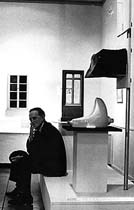
1999 Succession Marcel
Duchamp, ARS, N.Y./ADAGP, Paris.
In 1963 the Pasadena Art Museum in California presented Marcel Duchamp’s first retrospective exhibition. Organized by the young curator Walter Hopps, this exhibition introduced, for the fist time, Duchamp’s works to the West Coast’s spectators and artists. The exhibition space was designed according to themes based on Duchamp’s works. His early Cubist-influenced paintings(including two versions of Nude Descending A Staircase, 1911-12) were shown in one room, and a replica of The Bride Stripped Bare by Her Bachelors, Even, 1915-23, was shown in another room with some of Duchamp’s ready-mades (such as Fountain, Paris Air,and Traveler’s Folding Item). The exhibition’s announcement implicitly mentioned an ongoing Duchamp project (which was, in fact, Étant Donnés, Duchamp’s famous posthumous work,revealed to the public after his death) but no evidence of this project was displayed at the exhibition.
(1)
Juan Antonio Ramírez,Professor of Art History at the Universidad Autónoma de Madrid and author of several books on art, architecture and film, has written Duchamp: love and death, even along the same themes as the Pasadena Art Museum’s retrospective, with an interesting and telling twist of perspective. The book focuses on three topics: Duchamp’s readymades, The Bride Stripped Bare by Her Bachelors, Even,and Étant Donnés. In the last chapter, the book provides an appendix addressing Duchamp’s early paintings. A shift has been made from the importance of his early work (so carefully spotlighted in the retrospective exhibition) to the profound importance of Duchamp’s final piece.
click to enlarge
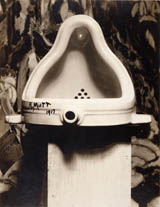
©1999 Succession Marcel
Duchamp, ARS, N.Y./ADAGP, Paris.
First, Ramírez addresses the readymades and describes a “readymade” as a work of art that has been, prior to the artist’s handling, “‘already-made,’ or previously produced. The artist does not create, in the traditional sense of the word, but chooses from among the objects of the industrial world or (to a lesser degree) the world of nature.” Ramírez then summarizes Duchamp’s readymades according to their “degree of rectification,” the “complexity of the assemblage” and the “degree of necessity for manipulation […] and structure.”(2)Here, Ramírez tries to link the concept of the readymade to industrial production by highlighting the technical and material aspects of the readymade. On the other hand, he also suggests there is a sensual quality to the readymade. The form of the readymade renders its industrial counterpart an aesthetic sense, even an erotic one. Therefore, the readymade, for the author, presents us with a double character, showing us both industrial significance and erotic pleasure.
click to enlarge
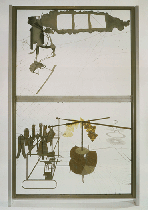
©1999 Succession Marcel
Duchamp, ARS, N.Y./ADAGP, Paris.
Following this,Ramírez spends two chapters discussing Duchamp’s The Bride Stripped Bare by Her Bachelors, Even. Chapter Two begins the topic from the bachelor section of The Bride Stripped Bare by Her Bachelors,Even and Chapter Three moves to the section of the bride. By referring to notes in the Green Box, the author explicates the functions of the mechanical apparatuses in the bachelor section. For example, he gives a detailed chart showing the elements and significance of the malic moulds. The author compares Duchamp’s apparatuses with those of the industrial culture of that time, and he indicates that these industrial designs inspired Duchamp.
click to enlarge
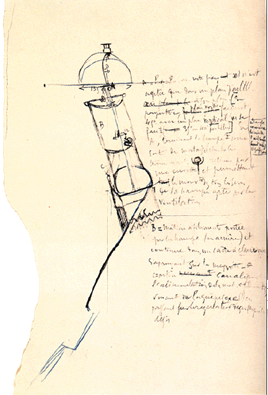
©1999 Succession Marcel Duchamp,
ARS, N.Y./ADAGP, Paris.
The bachelor section illuminates a precise and solid blue print of a mechanical device which reveals a masculine sense. In opposition to this masculine sense,the bride section conveys a feminine sense. The left side of Female Pendant (“Bride Hanging” or, the top portion of The Bride Stripped Bare by Her Bachelors, Even) in 1913 shows a female figure, and the composition of this female figure echoes the optical concern in Oculist Witness of the bachelor section.(3) Ramírez further suggests that a transparent body is contained in the area known as the Milky Way of the bride’s section. “The human being with his halo can be contained within the cinematic expansion [otherwise known as the Milky Way] of the bride.” Finally, an electronic circulation between the bride and the bachelor functions according to the devices of Tender of Gravity, Tripod, Rod,and Black Ball. This circulation implies, perhaps, the sexual relationship between woman and man (the bride and the bachelor).
click to enlarge
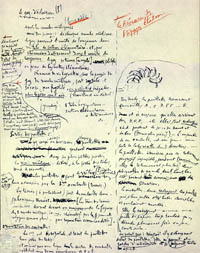
©1999 Succession Marcel
Duchamp, ARS, N.Y./ADAGP, Paris.
In chapters four and five, the author undertakes the shift from The Bride Stripped Bare by Her Bachelors, Even to Duchamp’s most secretive work, ÉtantDonnés. According to a Green Box note, Ramírezdraws a possible link between these major pieces.(4)He believes that Étant Donnés continues what Duchamp didn’t finish in The Bride Stripped Bare by Her Bachelors, Even.Also, Ramírez shows how several of Duchamp’s early works relate to Étant Donnés. La Bagarre d’Austerlitz (1921), for instance, corresponds to the Spanish wooden door of Étant Donnés. He surveys Duchamp’s oeuvre and finds direct inspiration for the design of not only the door, but also the brick wall, landscape, table, electrical installation, and female torso in Étant Donnés. Ramírez elaborates upon the construction of Étant Donnés in detail.
click to enlarge
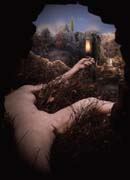
©1999 Succession Marcel
Duchamp, ARS, N.Y./ADAGP, Paris.
Both Maria Martins and Teeny Duchamp served as models for the piece and Ramírez asserts that Étant Donnés was begun as a result of the erotic influence of Martins upon Duchamp.(She was later “displaced”by Teeny Duchamp.) The author places the composition of the female torso of Étant Donnés into the context of some nineteenth-century figurative paintings and twentieth-century surrealist works. The works of Jean Léon Gerôme, Courbet, and Cézanne, for example, directly or indirectly influenced Duchamp’s design of the female figure. Also, the photos of Man Ray and Hans Bellmer and the paintings of Magritte, Max Ernst and Paul Delvaux evoke a female figure, similar to the one in Étant Donnés, which epitomizes surrealist fascination with the erotic and the sexual.
In the last chapter,Ramírez introduces Duchamp’s earliest eight paintings: Landscape
in Blainville (1902), Nude in Black Stockings (1910), Portrait of Dr. Dumouchel (1910), Paradise (1910-11), Spring(1911), Dulcinea (1911), Coffee Mill (1911), Nude
Descending a Staircase No. 2 (1912), and The King and Queen Surrounded by Swift Nudes (1912). These paintings, created during Duchamp’s Paris period before 1912, show the influence of late-Impressionism, Symbolism, Fauvism, and Cubism on his early career. Ramírezdescribes and captures Duchamp’s growth as an artist during this time,noting that, finally in 1912, with Queen Surrounded by Swift Nudes, “Duchamp had exhausted the possibilities of this thousand-year-old art form at the same rapid pace as his nudes – that is to say, vertiginously.”
click to enlarge
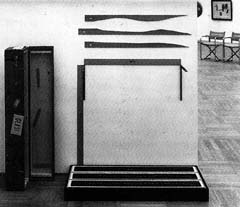
©1999 Succession Marcel
Duchamp, ARS, N.Y./ADAGP, Paris.
click to enlarge

©1999 Succession Marcel
Duchamp, ARS, N.Y./ADAGP, Paris.
In Duchamp: love and death, even, Ramírez fails to deal with several key points. He classifies Trois stoppages (“Three Standard Stoppages”) of 1913-14 as a readymade while most Duchamp scholars don’t attribute the work as a readymade. Duchamp explained the process of this work to Richard Hamilton: “Three canvases were put on long stretchers and painted Prussian blue. Each thread was dropped on a canvas and varnish was dropped on the thread to bond it on a canvas. The canvases were later cut from the stretchers and glued down onto strips of plate glass.”(5) Trois stoppages, in this sense, is Duchamp’s experimentof chance, not a readymade. Second, Ramírez draws a direct link between the female figure (called the “Sacrificial Dummy” in his book) and Duchamp’s intimate relationship with Maria Martins. In fact, Duchamp already had a similar idea in mind, and it appears in note 142 of the Green Box.In the note, there is a figure’s head and the inscription: Give The Object., considered in its physical appearance. (color, mass, form.)/define (graphically i.e. by means of pictorial conventions). the mould of the object./By mould is meant: from the pt. Of view of form and color.(6) So perhaps Martins is not the key to Duchamp’s ideas about designing a female figure.
click to enlarge
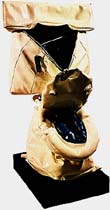
Claes Oldenburg, Soft Toilet, 1966
On the other hand,Ramírez offers some convincing and intriguing interpretations of Duchamp’s art. He shows that Duchamp’s experience of life does not tie in with his final creation and that love, intellectual rigor and sense of humor play out as the three threads that shape the core of Duchamp’s works. Furthermore, because Duchamp’s art reflects his particular interest in industrial culture and society, Duchamp challenges the orthodox discourse of traditional art and builds a provocative route for the modern art that later prompts the emerging of contemporary art in the 1960’s and 70’s. Duchamp’s oeuvre maps the avant-garde art and establishes him as one of the most important figures of twentieth-century art and culture.
Notes :
 1. The whole announcement is folded in half. The front view shows Duchamp looking at the viewer and standing close to a door as if he is entering a room from outside. The door is reminiscent of Duchamp’s Door: 11, rue Larrey, 1927. The design of the back view, showing a hole, foreshadows Duchamp’s two peep holes on the door of Étant Donnés.
1. The whole announcement is folded in half. The front view shows Duchamp looking at the viewer and standing close to a door as if he is entering a room from outside. The door is reminiscent of Duchamp’s Door: 11, rue Larrey, 1927. The design of the back view, showing a hole, foreshadows Duchamp’s two peep holes on the door of Étant Donnés.
When Hopps was working on the exhibition, he had an interview with Duchmap. He asked Duchamp: “If there were something you had been working on privately,would this have been the show that you would have wanted it to be seen in?” And then Hopps noted: “After this exchange, I was quite convinced in my own mind that time would turn up something important,as indeed it did.” (Bonnie Clearwater ed., West Coast Duchamp,Florida: Grassfield Press, 1991, p. 121.)
Later, Hopps realized nof course that Duchamp had been secretly working on Étant Donnés.
 2. The readymadesare examined under “technical aspects and materials,” “geometrical and/or speculative aspects,” “erotic significance,” “relations with the large glass,” “other aspects.”
2. The readymadesare examined under “technical aspects and materials,” “geometrical and/or speculative aspects,” “erotic significance,” “relations with the large glass,” “other aspects.”
 3. According to the note in the Green Box, it says that “this angle will express the necessary and sufficient twinkle of the eye.” (Author’s italics.)
3. According to the note in the Green Box, it says that “this angle will express the necessary and sufficient twinkle of the eye.” (Author’s italics.)
 4. Étant Donnés: 1. La chute d’eau, 2. Le gaz d’éclairage.
4. Étant Donnés: 1. La chute d’eau, 2. Le gaz d’éclairage.
 5. Richard Hamilton, The Almost Complete Works of Marcel Duchamp(London: the Arts Council of Great Britain, 1966), 48.
5. Richard Hamilton, The Almost Complete Works of Marcel Duchamp(London: the Arts Council of Great Britain, 1966), 48.
 6. Arturo Schwarz ed., Marcel Duchamp: Notes and Projects for The Large Glass (New York: Harry Abrams Inc., 1969), 210.
6. Arturo Schwarz ed., Marcel Duchamp: Notes and Projects for The Large Glass (New York: Harry Abrams Inc., 1969), 210.